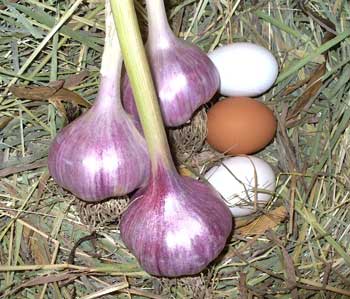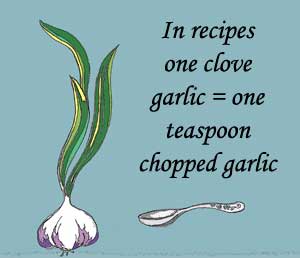Basic Garlic Cooking Tips
Cook with fresh garlic for a flavor explosion!
Fresh garlic will add an unforgettable flavor to your cooking. You can be a 'good' cook without using fresh ingredients, but to be a truly GREAT cook you need to explore the flavorful explosion that develops in a dish when you add fresh ingredients. I enjoy matching the garlic varieties I have to the dish.
For success with garlic consider these cooking tips.
Picture: Chesnok Red garlic bulbs snuggle with farm fresh eggs in a nest of hay.
Choose the right size clove:
All cloves are not created equal. The average supermarket clove weighs about 4-7 grams. The cloves in gourmet garlic weigh from 4-45 grams depending on garlic variety and size of bulb. Our average garlic clove weighs between 10-16 grams.
Since most recipes call for cloves it is important to know how to convert from cloves to a more standardized measurement. Otherwise you may add a lot more garlic than you really want!
Clove substitution chart:
1 clove = 1 teaspoon chopped fresh garlic or ½ teaspoon minced fresh garlic
1 clove = 1/4 teaspoon dried, dehydrated or powdered garlic
 Flavor Intensity:
Flavor Intensity:
Different gourmet varieties vary in intensity, heat and taste. Most fresh hardneck garlic is stronger than softneck garlic bulbs from the store. Go easy on the garlic at first until you determine your particular preference. Remember, it is easy to add more but impossible to subtract! Flavor intensity can be influenced by type of garlic, curing of garlic, cooking time and how you chop garlic.
Cooking Time:
In general, garlic flavor becomes milder the longer you cook it. Some garlic varieties, such as Romanian Red and Parvin remain hot and flavorful throughout the cooking process. Raw garlic is the hottest and baked garlic the mildest!
Cook Under Medium or Low Heat:
Don't burn garlic or it will become bitter. This will spoil the taste of your dish.
Chop Smaller for More Flavor:
The finer you chop your garlic, the more intense the flavor. To decide whether to slice or mince ask yourself two questions:
-
Do I like garlic or do I LOVE garlic? If you love all things garlic you may want to turn up the heat by mincing your garlic or squeezing it through a garlic press. If you prefer a more subtle hint of garlic, slice or dice the garlic into larger chunks before adding it to a dish. I like to grate big cloves on a cheese grater (also works great for ginger).
-
What type of dish am I making? Hardy Italian dishes are expected to be infused in garlic; delicate Asian stir-fries may need a lighter touch. Raw dishes or dip require less garlic than cooked dishes. Cooking garlic makes it sweeter and milder. Garlic becomes milder as it cooks. Adding garlic early in the cooking process will result in a milder flavor than adding it later.
Baking Tips:
For the sweetest garlic, bake heads or cloves in a covered dish. Don’t bake garlic uncovered or it will become hard and tough. To make delicious gravies for roasts, add several garlic cloves to the roast when you bake it. After cooking the roast, smash the baked cloves in the meat’s juices when you make the gravy to add a sweet and savory garlic flavor.
Use Different Garlic Varieties for Unique Flavors:
Gourmet garlic is one of the easiest ways to add a unique flavor to a dish. By varying the type of garlic you use in a recipe you can add any flavor including:
- Complementary hints of garlic (Siberian)
- An unapologetic wave of true deep garlic flavor that lasts (Bogatyr)
- A bold heat (Lorz Italian)
- Complex sweet undertones that complete a dish (Asian Tempest)
- Delicious round flavor that adds a real profession touch (Tzan)
- Crisp clean garlic flavor (Georgian Crystal)
- An riotous explosion of heat and flavor (Romanian Red and Parvin)
- Hot peppery taste (Parvin)
- A mellow garlic flavor without heat (Thermadrone)
- Complex garlic flavor beautifully dressed for any occasion (Red Rezan)
- Sweet roasting flavor (Chesnok Red)
- A mild green bite (green garlic of all varieties)
For more on how to select the perfect garlic for a dish, see our chef's guide to garlic.
